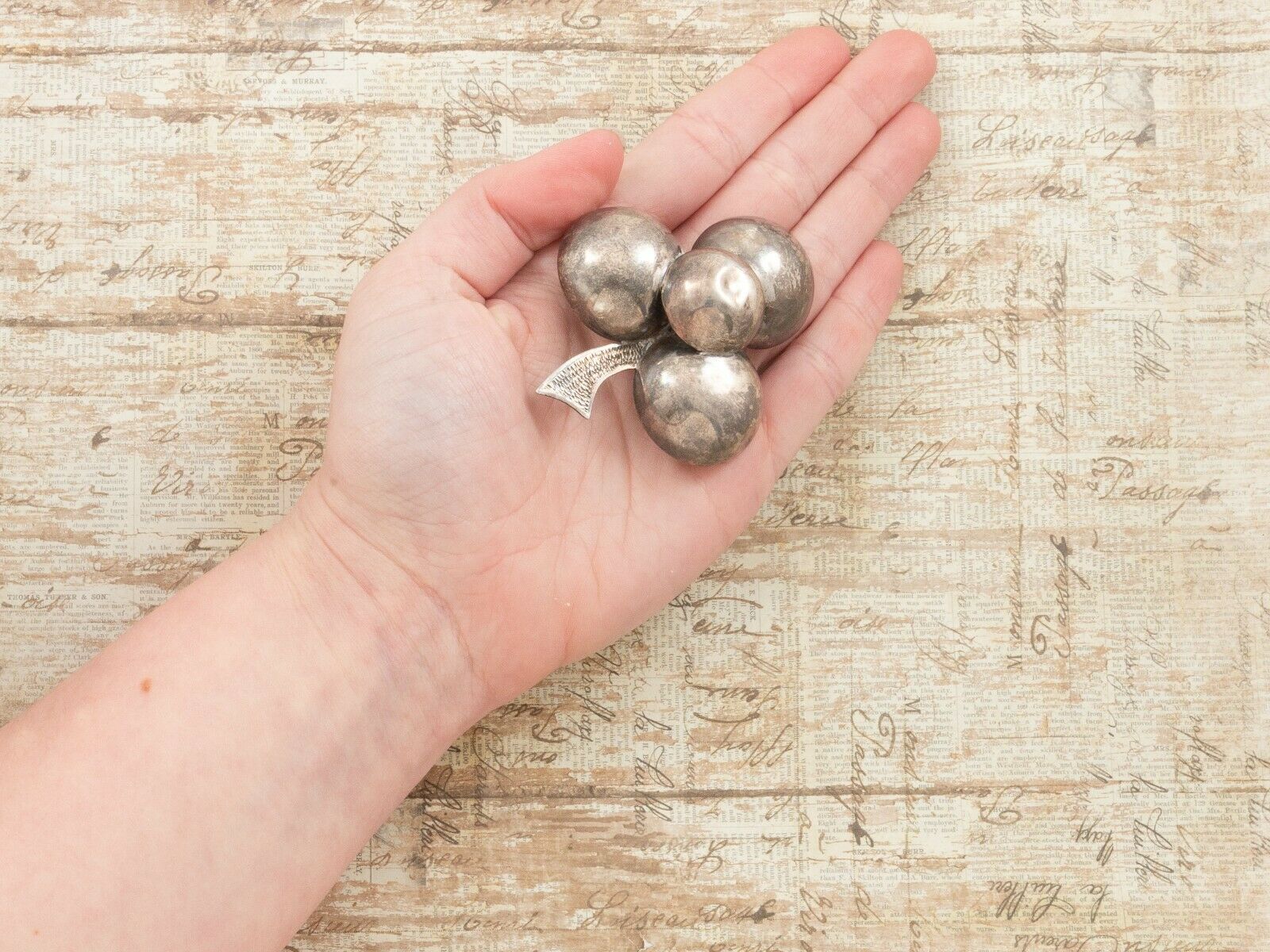-40%
Antique Vintage Deco Retro Sterling Silver TAXCO ABRAHAM TOBIAS Pin Brooch 22.4g
$ 35.9
- Description
- Size Guide
Description
This brooch is part of a set with a matching pair of earrings, which we also have for sale this week. To view in separate listings, please visit our store and search "Retro" and "Taxco" under our Buy-It-Now items.Listing Description by: Angela A.
The Piece
Age Circa:
Retro C. 1940 - 1950
Markings:
"Mexico Silver" and "Tobias A" on the back of the brooch, tested, and guaranteed
Country of Origin:
Mexico
Brand:
Taxco - Abraham Tobias
Gram Weight:
22.4 grams
Metal Type:
.925 sterling silver
Material:
--
Main Stone:
--
Main Stone Measurements/Color:
--
Accent Stone:
--
Accent Stone Measurements/Color:
--
Stone Treatment:
--
Stone Cuts:
--
Item Measurements:
Length
: 2.70"
Width
: 2.21"
Pin/Brooch Style:
Brooch, lapel pin, hat pin, scarf pin, tie pin
Closure Type:
Pin stem with a locking "c" clasp
Convertible to Necklace Pendant:
If desired, your local jeweler can add a bale to this piece, so it can be worn as a pendant.
Notable Features:
Handmade during the Retro period by the talented Mexican Taxco silversmith Abraham Tobias, known for his repousse work
The brooch is composed of .925 sterling silver
Features a berry or grape-like motif with four huge, rounded domes and a stem design
These eye-catching domes were created using the repousse metalworking technique, and are rare examples of hollow puffy jewelry
Completed with a pin stem and locking "c" clasp and can be worn on a variety of accessories, including hats, scarves, and lapels, among many others
Part of a set with a matching pair of earrings, which we also have for sale in a separate listing
Damage:
Age appropriate wear. There is a dent in the upper dome, which does not affect wear. The end of the pin stem is slightly bent, though this also does not affect wear. This lovely item displays tarnish, which gives the piece an antique quality we believe is rather lovely. The price has been reduced to reflect this.
*This listing is for the item only. All display boxes and/or photography props do not come with your purchase.*
The History
The Art Deco era is famous for being the "Gatsby" or "Roaring Twenties" era. Many gorgeous and timeless jewelry designs emerged from this period. Jewelry from this period was most often crafted between 1920 and 1940. Art Deco jewelry sometimes featured white gold or platinum, geometric designs, European cut diamonds, filigree, and calibre cut stones that are specifically cut to fit the design of the piece. During the Art Deco period jewelers often made jewelry upon custom order, this would often take weeks to months to completely craft by hand.
Retro jewelry refers to pieces created in the 1940s and 1950s. This was a period during which jewelry designers were largely influenced by the changes stemming from World War II. These designs reflect an infusion of futuristic vision with elements inspired by preceding periods, encompassing a variety of gemstones, shapes, and materials. Materials used commonly in Retro jewelry are gold, gold alloys, and silver as the wartime put a restriction on the used of platinum. Designs can be masculine, geometric and modern, or softer, more feminine and floral.
Taxco, Mexico is famous for producing the finest sterling silver jewelry in the world. Taxco has a rich history of silver-making, with the Aztecs being the first to mine and craft sterling silver for adornment and ceremony. In the 1920s, an American artist named William Spratling moved to Taxco. Being inspired by pre-Columbian and Aztec art, Spratling built a successful jewelry business. Many local aspiring artisans started apprenticing under him, and he eventually developed an apprenticeship program, with many famous silversmiths having learned there. The Taxco tradition of silversmithing is still carried on by the local artisan community today.
Repoussé began as an ancient metalworking technique dating as far back as the 3rd century BC, involving malleable metal that was hammered onto the reverse side to create an image on the front. Examples are found all over the world; Greece, Egypt, and even the Hopewell periods in the American southeast. Reverse side hammering was also used to add detail to the front, creating intricate patterns using grooves, indentations, and channeling. The piece was then carefully polished to create a hollow, eye-catching treasure.
Puffy jewelry is a name given to hollow repousse pieces, typically little heart charms. Puffy hearts came into fashion in the late 1800s and were popular until the 1950s. Today, puffy jewelry is highly sought after, but very rare to find because they were difficult to make in the first place and were easily damaged due to their hollow cores.
Domestic US
: All items ship within one business day of receiving payment. Buyers will have 3 base shipping options to choose from, depending on the needed speed of delivery. Pricing on single and multi-purchase transactions can be seen below:
Auction Items:
Base shipping + .00 per additional gold item & BIN items combine for free
BIN Items:
FREE
Base Shipping:
USPS
First Class
: .00 fully insured, estimated 3-5 business days
USPS
Priority Mail
: .00 fully insured, estimated 2-3 business days
USPS
Priority Express
: .00 fully insured, overnight delivery
International
: All packages are sent via USPS and pricing is based on buyer location. Each customer will receive a revised invoice at the close of the auction with an updated shipping rate. We will combine shipping on multiple purchases for free.
We do not undervalue packages for customs, please do not ask us to do so. What you pay is what we will claim on your customs form.
Please take this into consideration before placing your bid.
PayPal only. After 4 days of non-payment, an automated unpaid item case will be opened by our eBay system. If you need extra time for payment, please contact us prior to bidding.











